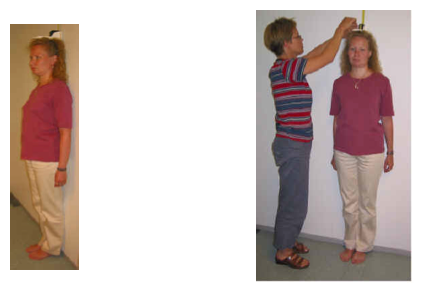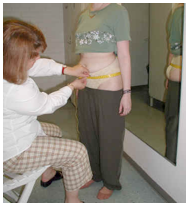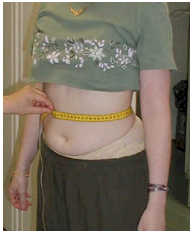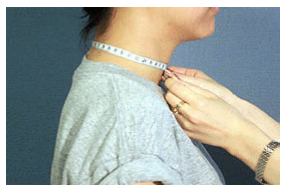Heart Biomarker Evaluation in Apnea Treatment
6.8 Measurements
6.8.1 Height
Standing Height is measured to the nearest cm with the subject in stocking feet, using a wall mounted Holtain Limited stadiometer or equivalent. The subject should be positioned with so that their heels, buttocks, back and head are touching the backboard of the stadiometer. For some obese subjects, and subjects with scoliosis, this may not be possible. In these cases, the goal is to position the subject so that the spine is as erect as possible. The head should be positioned with the Frankfurt plane parallel to the floor, i.e, the top of the external auditory meatus (ear canal) should be level with the inferior margin of the bony orbit (cheek bone). Once positioned, the participant is asked to take a deep breath in, and look straight forward. The head piece of the stadiometer or the sliding part of the measuring rod is gently lowered to the crown of the head, so that the hair is pressed flat. Record on the Physical Measurements Form in cm. Round to the nearest cm. If at a .5 cm, round to the nearest higher integer.
6.8.2 Weight
Weight is measured to the nearest 0.1 kg using a digital Healthometer digital scale or equivalent in stocking feet and with no blue jeans. Procedure: Assure that the scale is set to record in kg. The scale should be set to zero before the subject is weighed. Subjects should be instructed to stand on the center of the scale. Record on the Physical Measurements Form.
6.8.3 Hip Circumference
The subject should be instructed to stand erect with arms at the sides and feet together (for obese subjects, they should place their feet as close together as is comfortably possible). The measurer squats at the right side of the subject so that the level of maximum extension of the buttocks can be seen. An inelastic tape is placed around the buttocks in a horizontal plane at this level without compressing the skin. The tape should be parallel to the floor. The assistant (recorder) is needed to help position the tape on the opposite side of the subject’s body and assure that the tape is parallel to the floor. The zero end of the tape should be below the measurement value. The tape is in contact with the skin but does not indent the soft tissue. The measurement is done to the nearest 0.1 cm. Take measurement two times and record on the Physical Measurements Form.
6.8.4 Waist Circumference
The measurement should not be made over clothing. The subject stands erect with the abdomen relaxed, the arms at the sides and feet together. The measurer stands behind the subject and palpates the hip area for the right iliac crest, and draws a line just above the crest using washable marker. A second mark is made in the mid-axillary line. The measurer places a tape around this mark, horizontal to the floor. The subject is asked to turn slowly, holding the tape in position so that the tape wraps around. This assures that the tape is parallel and that the tape is snug but does not compress the skin. A mirror may be used to help judge that the position of the tape remains parallel to the floor and in line with the top of the hip crest. The measurement should be taken at the end of a normal expiration, to the nearest 0.1 cm. Measurements are made two times and record on the Physical Measurements Form.
6.8.5 Neck Size
Neck size is determined with a non-stretchable cloth measuring tape to the nearest 0.1 cm while the subject is seated with the head in the Frankfort horizontal plane, measuring at the point below the thyroid prominence, keeping the tape perpendicular to the horizontal axis of the neck. If the thyroid prominence cannot be located, ask the subject to swallow and feel for the “nob” that bobs up and down. In women, this may not be felt; use a point mid way along the neck, from the point. Take measurement two times, record on the Physical Measurements Form.



